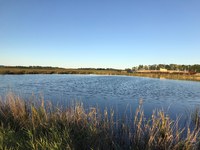Don’t Let Containment Ponds Overflow
(Click the image below to view a high-resolution image that can be downloaded)
With high water tables going into last fall and high water content in the snowpack this winter, spring thaw likely will cause issues for North Dakota livestock owners who have dirty-water containment ponds and manure stacking areas.
As the spring thaw continues, inspecting the dirty-water containment ponds daily is going to be important.
“Producers must maintain 2 feet of freeboard to accommodate a 24-hour, 25-year storm event in their ponds,” advises Mary Keena, Extension livestock environmental management specialist based at North Dakota State University’s Carrington Research Extension Center. “If a pond is level with or measuring in the freeboard area, producers must pump the pond.”
Rachel Strommen, environmental scientist at the North Dakota Department of Environmental Quality, says, “If your manure management dirty-water containment pond looks like it is going to overtop, is showing signs of major bank erosion or is being encroached upon by floodwaters, calling the North Dakota Department of Environmental Quality, Division of Water Quality, and reporting these issues before they happen is the best plan of action.”
She says producers who must pump their ponds back to 2 feet of freeboard should apply the containment water to cropland or pastureland as soon as the ground thaws.
“While the nutrient content of the containment water is minimal, it is important to have it sampled and record the number of gallons applied so your nutrient management plan can be updated to include the pumping,” Keena says.
If a containment pond has an unpermitted release, producers must call the North Dakota Department of Environmental Quality (NDDEQ) at 701-328-5210 to report the incident. Producers will be required to keep records of all weather events that caused the release, the date of the release, the time of the release, the location of the release, the volume of manure or runoff released, and the actions taken to clean up and minimize the release.
Another thing to monitor is manure stacking areas. If the area where producers are stockpiling manure, whether that’s the edge of the field or a designated stacking area, may be prone to overland flooding because of this year’s weather events, the producers should inspect it, Keena says.
Nutrients such as nitrogen and phosphorus are highly susceptible to dissolving in water or moving with the soil, causing pollution in runoff waters. If a manure stacking area becomes inundated with water and runoff, producers likely will need to build a berm around the area to prevent nutrient-dense runoff issues.
For more information about containment ponds, contact your local NDSU Extension agent (https://www.ag.ndsu.edu/extension/directory) or the NDDEQ Division of Water Quality at 701-328-5210 or https://deq.nd.gov/WQ, or check out these NDSU publications:
- “Containment Pond Management” - https://tinyurl.com/ContainmentPonds-NDSU
- “Manure Spills: What You Need to Know and Environmental Consequences” - https://tinyurl.com/MaureSpills-NDSU
- “Liquid Level or Depth Marker for Earthen Runoff Ponds” - https://tinyurl.com/RunoffPonds-NDSU
NDSU Agriculture Communication - March 14, 2020
| Source: | Mary Keena, 701-652-2951, mary.keena@ndsu.edu |
|---|---|
| Editor: | Ellen Crawford, 701-231-5391, ellen.crawford@ndsu.edu |


